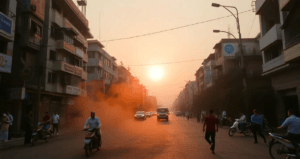Mumbai’s Rising Heat: Shocking 13°C Gap Exposes Urban Heat Island Effect
Mumbai is experiencing the urban heat island (UHI) effect, where densely built areas are significantly hotter than greener parts of the city. A study by Respirer Living Sciences found that between March 1 and March 22, 2025, neighborhoods like Vasai West (33.5°C) and Ghatkopar (33.3°C) recorded some of the highest temperatures, while Powai remained much cooler at 20.4°C, marking a striking 13.1°C difference.
Data from 22 CPCB monitoring stations confirmed similar disparities, with Colaba (32.4°C) being 9°C warmer than Chakala (23.4°C) and Ghatkopar (33.3°C) surpassing Chembur (25.5°C) by 7.8°C. Experts warn that these microclimates pose serious risks to public health, energy consumption, and urban planning. The primary causes include heat-absorbing infrastructure, limited green spaces, and high pollution levels. Ronak Sutaria, CEO of Respirer Living Sciences, emphasized the urgency of addressing heat stress in vulnerable neighborhoods.
To counteract the UHI effect, urban planners must prioritize tree cover, reflective building materials, and improved ventilation in congested areas. Without intervention, rising temperatures could severely impact Mumbai’s livability and resilience against climate change.

Mumbai’s Rising Heat: Shocking 13°C Gap Exposes Urban Heat Island Effect
Mumbai is facing a pressing environmental challenge known as the urban heat island (UHI) effect, where heavily built-up neighborhoods experience much higher temperatures compared to greener, less developed areas. A recent study by Respirer Living Sciences, a climate technology company, has revealed alarming temperature differences across the city, highlighting how rapid urbanization is reshaping local climates.
Stark Temperature Contrasts Across Neighborhoods
The study, conducted over three weeks in March 2025, uncovered dramatic temperature variations. Vasai West and Ghatkopar emerged as some of the hottest areas, recording average temperatures of 33.5°C and 33.3°C, respectively. In sharp contrast, Powai—a neighborhood dotted with lakes, parks, and open spaces—registered a cooler 20.4°C. This 13.1°C temperature gap within the same city underscores how urban development patterns directly influence local weather conditions.
Data from 22 air quality monitoring stations run by the Central Pollution Control Board (CPCB) reinforced these findings. For instance, South Mumbai’s Colaba area recorded 32.4°C, while Chakala in Andheri East averaged 23.4°C—a difference of 9°C. Similarly, Ghatkopar (33.3°C) was 7.8°C hotter than neighboring Chembur (25.5°C). These disparities reveal a city fragmented into distinct microclimates, where heat stress varies drastically from one locality to another.
Microclimates and Their Impacts
Ronak Sutaria, CEO of Respirer Living Sciences, explains that such temperature gaps signal the formation of localized microclimates. “Certain neighborhoods are becoming heat traps,” he says. “This isn’t just about discomfort—extreme heat can strain public health systems, spike energy demands for cooling, and challenge urban planners to rethink infrastructure.” Areas with dense concrete structures, minimal greenery, and high pollution are particularly vulnerable, acting as heat sinks that absorb and radiate warmth long after sunset.
The UHI effect is driven by multiple factors. Concrete buildings, asphalt roads, and industrial zones absorb sunlight during the day and slowly release heat at night, preventing cooler temperatures. Shrinking green spaces compound the problem, as trees and water bodies—which naturally cool air through shade and evaporation—are replaced by buildings. Additionally, pollution traps heat close to the ground, creating a “blanket effect” that worsens warming.
Health, Energy, and Livability at Risk
Rising temperatures pose serious risks. Prolonged heat exposure can lead to heatstroke, dehydration, and worsen chronic illnesses like asthma. Vulnerable groups, including outdoor workers, the elderly, and low-income communities with limited access to cooling, face heightened dangers. Energy consumption also surges as residents rely more on air conditioning, straining power grids and increasing greenhouse gas emissions—a vicious cycle that fuels further warming.
Urban planners warn that unchecked UHI effects could make parts of Mumbai increasingly unlivable. Narrow streets, overcrowded housing, and heat-retaining materials in slums amplify discomfort, while affluent areas with gardens and water features remain relatively cooler. This inequality highlights the need for inclusive climate adaptation strategies.
Cooling Solutions for a Hotter City
To combat rising temperatures, experts suggest redesigning urban spaces to prioritize sustainability. Key solutions include:
- Expanding Green Cover: Planting trees along roads, creating urban parks, and installing green roofs or vertical gardens can lower temperatures through shade and evapotranspiration. Powai’s lush landscape keeps it significantly cooler than neighboring areas.
- Heat-Reflective Materials: Using light-colored paint on buildings, reflective roofing, and permeable pavements can reduce heat absorption by deflecting sunlight instead of trapping it.
- Improving Airflow: Designing wider streets, preserving natural wind corridors, and reducing building density in heat-prone zones can enhance ventilation, dispersing trapped heat.
- Pollution Control: Cutting vehicular emissions and industrial pollution would reduce the heat-trapping layer, allowing nighttime temperatures to drop faster.
A Call for Collaborative Action
Addressing Mumbai’s heat divide requires cooperation between citizens, urban planners, and policymakers. Simple measures like painting roofs white or installing rooftop solar panels can make a difference at the community level. On a larger scale, integrating climate resilience into urban policies—such as mandating green spaces in new developments or retrofitting old buildings—is critical.
As Mumbai continues to grow, balancing development with environmental sustainability will determine its ability to withstand rising temperatures. The city’s experience serves as a warning for other rapidly urbanizing regions: without proactive measures, the urban heat island effect could deepen inequalities and compromise the livability of cities worldwide.
The findings from Respirer Living Sciences underscore an urgent truth—Mumbai’s climate crisis is not just a future threat but a present reality. Tackling it demands immediate action to cool the city’s hottest neighborhoods and ensure a safer, healthier future for all residents.
You must be logged in to post a comment.